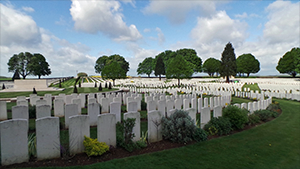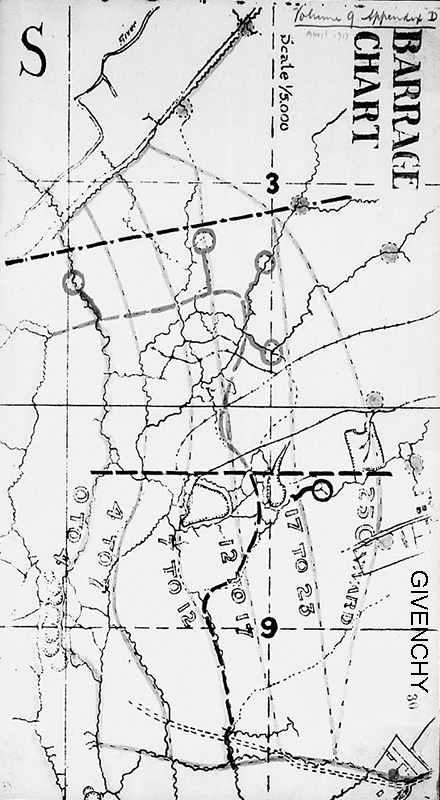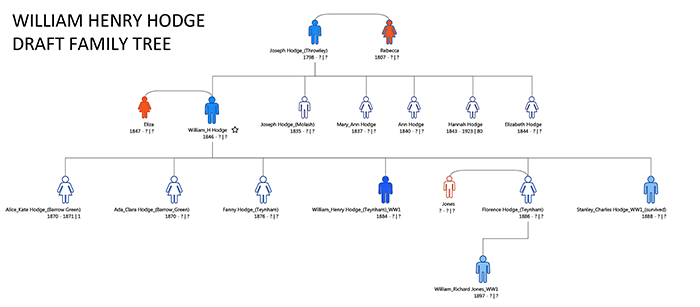First World War Project
William Henry HODGE (of Teynham)
b. 15th November 1884 Private, Service Number 434905 |

William Henry Hodge (Senior) with Eliza raised his family in Teynham, Barrow Green and Conyer employ in the local brickfields as a moulder. Their children were: twins Alice Kate and Ada Clara, Fanny, William Henry (Junior), Florence and Stanley Charles. Both sons (brickfield workers) served in the first world war but Stanley survived.
Both William and Stanley were "Teynham Pals" who emigrated to find opportunities in overseas territories - Canada in their cases - only to return to serve in the Great War. Stanley remembered his brother through this inscription on his headstone - "When the Day Breaketh". Did this call to his mind the Particular Baptist (Charles Spurgeon) commentary on Psalm 70, depicting the moment that God awakes to pass final judgement?
William's military medical describes him as aged 30, 5 feet 7 inches tall with a chest of 36", expanding by 3". His and his brothers' complexions are Dark, with brown eyes and hair but has no distinctive marks.
As a single man, his Military Will of 28th February 1916 made his mother sole legatee to receive his effects. [See Appendix 2]
He was posthumously awarded the British and War Medals but was not eligible for the 1914-15 Star. [See Appendix 1]
| East Kent Gazette of 2nd June and (in the same words) in the Faversham and North East Kent News of 12th May 1917 |
TEYNHAM. KILLED IN ACTION.- In the capture of the Vimy Ridge, the parish of Teynham lost one of the soldier sons, serving in the Canadian Forces, namely Private William Henry Hodge, son of Mr. and Mrs. Hodge, of Barrow Green. An Army Chaplain, in a letter conveying the sad news to his parents, wrote that their son "was killed in action while we captured one of the stongest enemy positions on the Western Front." He adds, "All our boys fought bravely in the most trying circumstances; unfortunately your son fell in the fray." Private Hodge, who was a single man, 32 years of age, went out to Canada about nine years ago. His brother, Stanley, who also went to Canada, joined up at about the same time as the deceased, and they were at the Front together. A grandson of Mr. and Mrs. Hodge, Driver William Richard Jones, Royal Naval Division, is also at the Front, and a son-in-law, Corporal John Kerr, is in Egypt. A singular circumstance is that the grandson met his uncle who has been killed and whom he had not seen for nine years, only two days before the action in which he lost his life." He missed his parents' Golden Anniversary, reported in the Faversham and North East News of 17th August 1918 - "Mr and Mrs William Henry Hodge, of Barrow Green, Teynham, celebrated their golden wedding last Friday. They both belong to Borden, but immediately after their marriage moved to Teynham where Mr. Hodge has worked for fifty years. The old people's eldest son, William Harry Hodge, was killed at Vimy Ridge, on April 10th last year, at the age of 32 years, and the younger son, Stanley Charles Hodge, who is in the Canadian Forces, is at present in hospital, he having been badly gassed about a fortnight ago. Two grandsons of Mr and Mrs Hodge are also serving. |
Military Experience of William Henry Hodge
Giving his occupation as "labourer", William attested at Medicine Hat on 6th February 1915. On 27th October 1915, he sailed from Halifax, Nova Scotia, for England aboard the S.S. "Orduna", which had only just returned from transporting $1,250,000 in gold from British to American bankers.
William arrived in England on 6th November and only one month later was admitted to Connaught Hospital, Aldershot with a misdiagnosis of VD Gonorrhoea, later corrected to influenza and discharged on 14th December 1915. Almost a year later, William fell foul of a serious bout of influenza that laid him low for several months.
It wasn't until 10th August 1916 that William joined the newly formed 50th Battalion Canadian Infantry and embarked for France from Bramshott Camp, Hants, through Southampton. Most of the infantry travelled on HMT "La Marguerite" with the exception of the Transport Section and one hundred men who were carried on HMT "Courtfield". At Le Havre ('Harve'), the following morning, the Battalion was made up of 46 officers and 1,020 other ranks. They arrived at Godewaersvelde on 13th August and went into billets nearby on the Steenvoorde and Abeele Road. On 19th August, they moved into trenches for the first time and the diary records the first casualty as Major L.O. Webster. It was not long before casualty figures increased as the trench warfare close to Ypres unfolded.
The story of William's medical admissions with influenza provides us with substantial pauses in his experience and location during 1916 and early 1917. As he was eased back into military action, he experienced a short period as Acting Lance Corporal in the 4th Entrenched Battery in 1917.
On 23rd November, William was admitted to 7th Canadian General Hospital, Étaples, with influenza. It is not clear when William was sent to hospital because O.R. sick records were not recorded in the War Diary. We do see several officers evacuated sick: 7th Nov. Lieut. A.F. Pringle; 11th Nov. Lieut-Col. E.G. Mason and Lieut. J.F. Proctor; 14th Nov. Lieut W.J. Davies. Within this span of a week, it is probable that William was also evacuated.
November opened with the 50th Battalion in rest billets at BOUZINCOURT and ALBERT, the Battalion having moved south to the Somme theatre. While William was on his way to Étaples Hospital, 120 kilometres away, on 17th November, the 50th Battalion was in the Front Line in X.II.A CHALK PITS SAUSAGE VALLEY. Orders received for "A" and "B" Companies with twenty Other Ranks volunteers each from "C" and "D" Companies to go over top on the morning of 18th inst. Night spent in preparation. Capt A.D. Harper and Lieut W.L.K. Williams and six O.R. wounded.
18th November: At dawn barrage was put on enemy's front line. The two companies who were assembled, went over top and when the barrage was lifted assaulted the enemy's front line about three hundred yards in advance of REGINA TRENCH. Very bitter resistance was met with at this point. Two prisoners were taken and objectives gained. Owing to our Smoke barrage, the left flank lost touch with 75th Battalion Canadian Infantry who were on our left, this leaving about two hundred yards of enemy's trench still in their hands We advanced about two hundred yards and assaulted a small trench taking about sixty prisoners. We then withdrew to that portion of trench still in enemy's hands taking same and about fifty prisoners. We immediately began to consolidate just over the crest of hill directly in rear of this trench but owing to heavy casualties through being exposed to enfilade Machine Gun in fire we were forced to return to REGINA TRENCH. 1 officer LIEUT W.R. ELLIOT and sixty O.R.s strong.
Casualties being Lieut R.E.P Pryce-Jones and Lieut G.F. MacDonald being killed in action. Major J.S. Wright, Lieut. E.B. McLean, Lieut M.R. Boyd reported missing believed killed. Capt. B.N. Barret, Capt. J.F. Costigan, Lieuts. L.J. Hextall, D.S.B. McAllister-Thompson, F.L. Drayton, P.B. McNally and M.S. Parry wounded. Fourteen O.R.s killed. Fifteen O.R.s missing believed killed. Eighty-two O.R.s missing. One O.R. missing believed prisoner of war. Ninety-one O.R.s wounded.
On night of this date, Battalion went into billets at ALBERT, with the exception of "D" Company who went into front line LIEUT A.T. Lowes returned from Machine Gun Course.
20th November: Battalion in billets at Albert. "D" Company returned from front line. Body of late Lieut. R.E.P. Pryce-Jones was recovered and brought to Albert.
21st November: Battalion in billets at Albert. Late Lieut. R.E.P. Pryce-Jones was buried in Military Cemetery at Albert. Lieut L.J. Hextall died of wounds at No.9 C.C.S. at Contay. One hundred and fifty two O.R.s joined unit as reinforcements.
22nd November: Battalion in billets at Albert. Late Lieut. L.J. Hextall buried in Military Cemetery at Contay.
23rd November: Battalion returned to Chalk Pits, Sausage Valley.
William was moved from the 7th Canadian General Hospital to the 6th Canadian Depot on 2nd December 1916. It wasn't until 31st January 1917 that he was "discharged to base detail" and on the road to returning to his Battalion. However, before he returned, he was attached to 4th Entrenched Battery in the Field on 19th February. Perhaps he was still not yet fit enough for strenuous action in the trenches at a time when the 4th Australian Infantry Division were in Reserve in the Lorette Spur, close to Souchez, west of Vimy. His own Battalion (the 50th) was on the right flank of the 4th Battalion and the 3rd Infantry Battalion on the left.
From 1st to 21st March, William was Acting Lance Corporal for three weeks until his returned to his Battalion. On 1st and 2nd March, the artillery were active and trenches were warned of possible gas attacks before retiring to billets (Lapugnoy). There followed a period of rest billets and training at Estree Cauchie (Cauchy). Before the 4th Brigade was move to Bois des Alieux, William returned to the 50th Battalion and he reverted to the rank of private.
On 21st March, the 50th Battalion was "in the line" at CARENCY and when they returned to billets at Chateau de la Haie on 25th March, the diary records: "Reinforcements - 8 Other Ranks from 4th Entrenched Battalion." So we can assume that this was the day that William rejoined his comrades at arms.
The War Diary until 10th April lists several changes in officers but otherwise reads:-
"26th: Chateaux de la Haie (Vancouver Camp): Weather: fine, windy.
27th: Weather: heavy snowfall. Regimental Canteen Opened. Sergeant's Mess re-opened.
28th: Weather: Snow and sleet, misty.
29th: Weather: Rain, snow and hail.
30th: Weather: Fine but misty. Visibility poor - Battalion half-holiday for sports.
31st: Weather: Heavy rain at first, after fair but misty. 10.30pm: 4 Officers and 200 Other Ranks having proceeded up the line took part in Brigade Raid and were in the Enemy's trenches for approximately 20 minutes during which considerable destruction work was carried out on Enemy's Defensive works. For full report, map, casualties to see Appendix B - broadly, the report commented on the very poor condition of German Trenches; casualties amounted to 1 Officer injured, 2 O.R.s killed, 5 missing, and 30 O.R.s wounded, mostly slight.
Congratulatory messages were received from Corps, Divisional and Brigade Commanders and Officer Commanding Raid (Lt. Col. DAWSON).
April 1917 - Hill 145
1st: Vancouver Camp: The 10th Canadian Infantry Brigade were relieved for approximately ten days' special training, the Battalion remaining at Chateau de la Haie. Weather: Thunderstorms and heavy snow. Reinforcements: Lieuts H. Neves, J.R. Sharp and H.M. Blois.
2nd: Special training commenced for forthcoming operations. Weather: Fair, visibility poor. Reinforcements: 50 O.R.s from Divisional School.
3rd: Special training continued. Reinforcements: 44 O.R.s from Le Havre. Weather: Fine, visibility good. Lieut W.C. Overs detached (Injured).
4th: Weather: Fine and clear. Special training continued.
5th: Weather: Fine and clear. Special training continued. Major R.B. Eaton returned from England. 434109 C.S.M. J.T. Maccalterm, 435687 Sgt J.H. Neeland, 434722 Sgt R.J. Goodman and 435266 Sgt J. Ladler promoted to Temporary Lieutenants. Battalion Concert held, the Brigadier General Commanding addressed the Battalion.
6th: Weather: Heavy showers at intervals otherwise fine and clear. Lieut. R.J. Goodman appointed Grenade Officer.
11.00 a.m.: Major General D. Watson, C.B., Commanding 4th Canadian Division presented ribbons for medals recently awarded. The Brigade was drawn up in square formation under the command of Brigadier General E. Hilliam, D.S.O. No less that one D.C.M. and eight M.M.'s were awarded to N.C.O.s and men of our Battalion.
2pm: The Brigade Sports were held.
7th: Special training resumed. Weather: Fine and clear, cool breeze.
8th: In Front of SOUCHEZ: Weather: Moderately fine but cold.
7pm: The Battalion proceeded to the line, the 10th C.I.B. in support of 11th and 12th C.I.B.s. Companies were located in the Quarries S.8.b.5.0. Assembly completed at 11.30pm. Casualties: nil. Marching Strength: Officers 26, O.R.'s 657.
9th: SOUCHEZ, HILL 145: Weather: Cold and showery. The Battalion remained in the Quarries until (10.30pm) Orders were received to move to the MUSIC HALL Support Line. This movement was completed before midnight.
Casualties: 2 O.R.'s killed and 4 O.R.'s wounded.
10th: SOUCHEZ, HILL 145: Lt-Col L.F. Page reconnoitred ground in the vicinity of HILL 145 and orders for attack were issued. Disposition of Companies as follows: Major J.F. Costigan, "A" Company, Left; Capt. L.G. Eveleigh, "B" Company, Left Support; Capt L.O. Ivendson, "C" Company, Right Assault; Major L.G. Casewell, "B" Company - Right Support.
12.00 noon: The Battalion moved to Assembly point BASSO Trench Road Junction S.15.d.7.3 to Junction of BASSO and BILLY Trenches arriving at 2.45pm.
3.15pm: Zero Hour and Companies were in position at BEER Trench at that hour. The enemy put up strong resistance but objectives were reached and consolidation commenced at 3.45pm. Over 125 prisoners belonging to 18th and 261st Regiments were captured also 2 Machine Guns and 1 Trench Mortar.
11.00 pm: The Battalion was relieved by the 47th Battalion and moved back to the MUSIC HALL line. Relief being completed by 1.00am, April 11th. [See Appendix "C" - O.O. No.17A of 10-4-17]
Casualties were very heavy as follows:- [Weather - Some snow, cold and windy.]
| Officers | Killed | Wounded | Other Ranks | Killed | Wounded | Missing |
| Major J.F. Costigans | Capt. W.J. Eveleigh | 57 | 129 & 1 (at duty) | 31 | ||
| Lieut. G.R. Jensen | Capt. W.R. Cameron | Total O.R. Casualties | 218 | |||
| Lieut. J.I. Marcallum | Lieut. E.W. Storer | |||||
| Lieut. J.E. Stanffer | Lieut. Henes | |||||
| Lieut. H.M. Bloio | Lieut. G.S. Coward | |||||
| Lieut. C. Stubbs | ||||||
11th April: MUSIC HALL: Weather: Cold and showery
Supporting Documentation
Appendix 9: Operation Order No.16, Extracts
"1. On Sunday April 8th the 50th Battalion will leave Billets with complete equipment as previously detailed.
2. ORDER OF MARCH. The Battalion will move off at 7.00pm by Platoons each Platoon at least one Hundred yards in rear of preceding one and will proceed to CARENCY. At this point platoons will be sent on by Sections via SOUCHEZ DUMP and the DUCK WALK to KINGS CROSS, thence to QUARRY where they will be directed to Billets. The strictest march discipline must be maintained.
No smoking permitted EAST of HOSPITAL CORNER.
The leading section will not pass this Point before 8.30pm. Each Section will be led by a man acquainted with this Route, and care must be taken not to close up sections, but a distance of 50 yards maintained between Section Units."
Report on Attack on Hill 145 by 44th and 50th Canadian Infantry, April 10th 1917.
 In accordance with 10th Canadian Infantry Brigade Operation Order No. 63, the 44th Battalion moved in to accommodation in the SOUCHEZ TUNNEL, movement completed by 5 a.m.
In accordance with 10th Canadian Infantry Brigade Operation Order No. 63, the 44th Battalion moved in to accommodation in the SOUCHEZ TUNNEL, movement completed by 5 a.m.
At 6 p.m. on the 9th, order were received cancelling the attack on the PIMPLE area. The Battalion moved over and took up position in the MUSIC HALL Line behind the Battalion of the 11th Canadian Infantry Brigade, whose attack had been held up in the neighbourhood of HILL 145.
At 11 a.m., April 10th, I received orders to capture and consolidate, as an outpost line, the eastern edge of VIMY RIDGE lying beyond HILL 145; the Battalion frontage to extend from Left of 42nd Battalion to Junction of BESSY and BANFF Trenches.
DISPOSITIONS
"C" and "D" Companies (Assaulting Units) - BEER Trench.
"A" and "B" Companies (Support) - BEGGAR Trench.
Assembly all complete at 1.40 p.m., with very few casualties. My Battalion Headquarters was established in BEGGAR Trench at 2.20 p.m.
At 3.04 p.m., covering Artillery opened a glow barrage fire on our objective along BANFF Trench, continuing until ZERO time. At 3.15 p.m., intense barrage commenced, remaining on objectives for four minutes. "C" and "D" Companies moved out and forward under barrage.
When barrage lifted attacking parties moved forward in good order, touch being maintained with 50th Battalion on left throughout. At 3.21 "D" Company reached the Western edge of BOIS DE LA FOLIE, "C" Company entering BANFF Trench at the same time and working down BLIGHTY Trench.
Posts were quickly established as follows:-
One at Junction of BESSY and BANFF.
One at Junction of BLIGHTY and BANFF.
On the right "D" Company had gone difficulty in clearing the wood. Mopping up parties moved through to farther edge, capturing a good number of prisoners. Very heavy casualties were inflicted on parties of enemy who attempted to escape through wood. By 4.15 p.m., "C" Company had established a post close to Junction of BLIGHTY and BOOM. A further post was established by "D" Company at S.22.b.65.40., thus completing the task assigned to the 44th Battalion, in accordance with Divisional Plan.
Consolidation of positions was at once commenced.
Two machine guns were captured in this area, also 59 prisoners of the 261st R.I.R. These latter included one Officer and 6 N.C.O.s. In addition to this, wounded prisoners, exact number unknown, were carried out later by our Clearing Parties.
At 6.15 p.m. two Companies of the 47th Battalion moved in to relieve the 44th Battalion. The relief was complete by 8.30 p.m. Battalion moved out to accommodation in ARRAS ALLEY and MAISTRE LINE.
I desire especially to call attention to the excellent work done by Captain J.M. BAKER and Lieut. P. NEALE of the 44th Battalion.
Family of William Henry Hodge
Click family-tree for larger image


 World War 1 Pages
World War 1 Pages